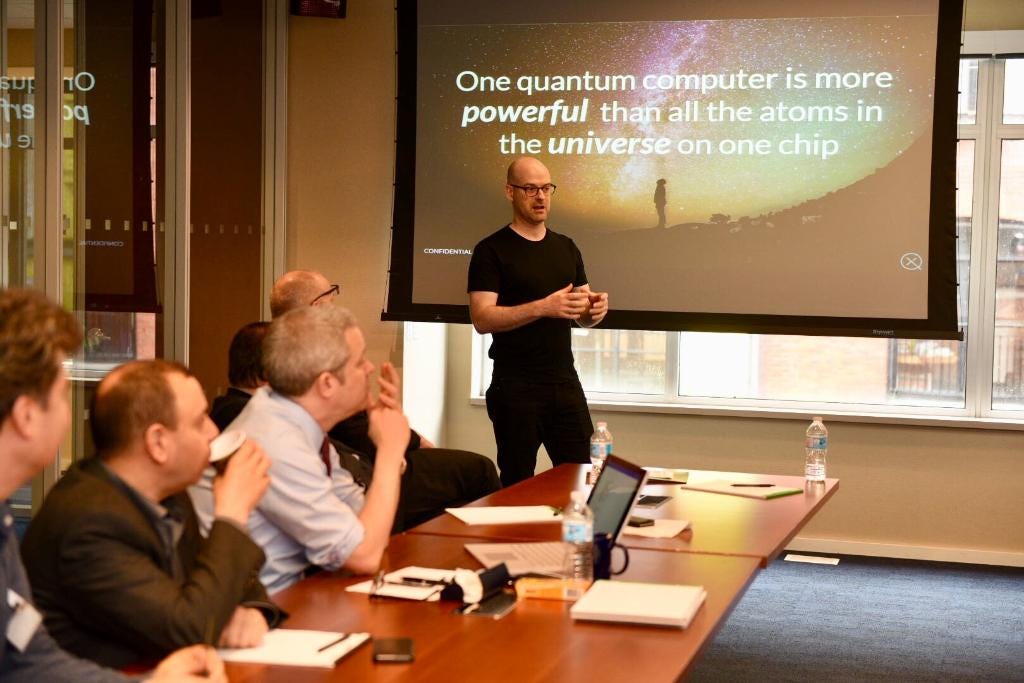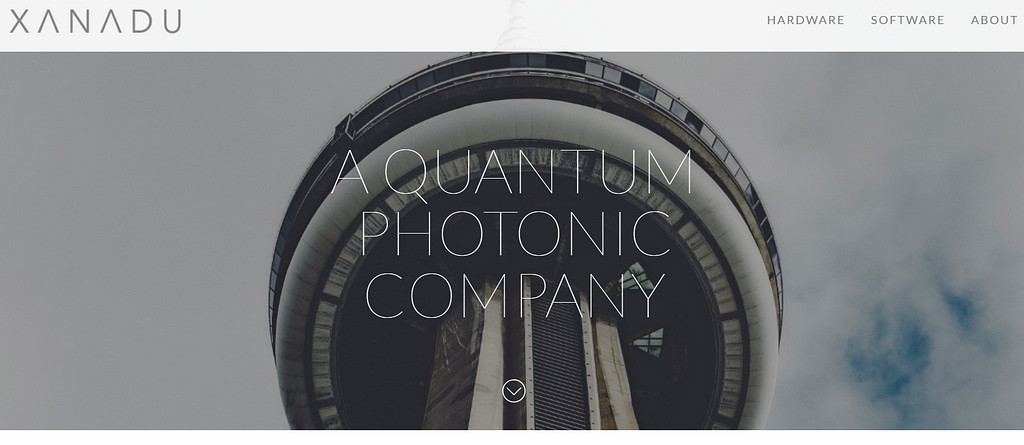Latest news about Bitcoin and all cryptocurrencies. Your daily crypto news habit.
 Christian Weedbrook addressing senior technologists in Montreal. Photo Courtesy: Morgan Stanley
Christian Weedbrook addressing senior technologists in Montreal. Photo Courtesy: Morgan Stanley
Christian Weedbrook is the Founder and CEO of Xanadu, a quantum technologies company powered by light. Xanadu designs and integrates quantum silicon photonic chips into existing hardware to create truly full-stack quantum computing. Their methods will solve today’s toughest business problems significantly faster than ever imagined.
Xanadu just launched the world’s first dedicated machine learning software for quantum computers, called Penny Lane (yes, after the Beatles song). Envisioned as the “TensorFlow of quantum computing,” the hardware-agnostic platform comes with built-in support for existing qubit and photonic quantum hardware.
Xanadu is an SVB Client and I interviewed Christian in Xanadu’s Toronto HQ. The below was edited for length and clarity.
Natalie: As an Australian, what made you move to Toronto and decide to become a Canadian citizen? Was it in order to build this company?
Christian: For personal reasons, actually. After getting my PhD in Australia I went to Boston then Toronto. I pretty much fell in love with Toronto. I grew up on acreage so I really wanted to live in a big city. There’s that city element and also a multicultural side of things here.
As far as the company, Xanadu is not going anywhere — we may have offices in other parts of the country but the headquarters will always be in Toronto.
On the about page of our website, we even have a picture of the CN Tower, and so many people told me not to put that image there, saying that it looks too cheesy, but when you come from a different country, you have a different appreciation for Toronto. If I had a will, it’d say “sprinkle my ashes from the CN Tower”.
I never want to move [away from Toronto]. If I had a will, it’d say “sprinkle my ashes from the CN Tower”
 Xanadu’s “About” page prominently featuring Toronto’s CN Tower
Xanadu’s “About” page prominently featuring Toronto’s CN Tower
N: In terms of hiring talent, what’s it like here?
C: We are a little unique in that the technology we’re developing comes from academia, so that means we have to hire from academia. We have thirty five people now approximately, and I tell everyone that working here is like a postdoc position — try it to see if you like it and we’ll be publishing everything. That allows us to get good talent. Everyone at the company I’ve either worked with previously or know from friends of friends in academia. That means we’re drawing from people all over the world. We’ve got so many nationalities here — it’s crazy. That shows you how popular quantum computing is becoming in universities around the world. I was a postdoc at University of Toronto and I think we’ve hired four people straight out of their PhD. I’ve worked at many universities — including Harvard and MIT — and the best of the best here are equal to the best of the best anywhere.
I’ve worked at many universities — including Harvard and MIT — and the best of the best here [in Toronto] are equal to the best of the best anywhere.
N: And what about hiring business talent?
C: 90% of the employees are quantum engineers, so we’re looking for more business hires now.
Recently I saw that there’s going to be a new MaRS innovation hub on the waterfront with Microsoft and Spotify putting money in. We can now start drawing on that talent, particularly from the non-technical business side. We went through the Creative Destruction Lab and in general, these incubator programs are a good example — they’re attracting a lot of talent.
One of the challenges that all companies here need to overcome over the next couple of years is — how do we make money from it? It seems like the talent, the ideas, and the R&D are all happening, but how do we start converting that into customers buying stuff? We need to convert talent into actual profits.
That’s something we are very focused on. We’re solving a very tough technological problem but we also want to show that we’re thinking like a business and not like a science experiment. We say we’re full stack, which means hardware, software plus business. We talk to customers from day one and are focused on solving their problems using the technology instead of the other way around.
We say we’re full stack, which means hardware, software plus business. We talk to customers from day one and are focused on solving their problems using the technology instead of the other way around.
N: What was it like raising capital here?
C: We raised $9M from all Canadian VCs — OMERS Ventures, Golden Ventures and Real Ventures. Some people say it’s unusual to raise a seed round of $9M just from Canadian funds so we’re really proud of that, it’s pretty awesome. For the next phase, the Series A, we’re looking to have our Canadian investors follow on but also looking toward the Valley.
N: Curious for some predictions from you. What will be the killer app in quantum?
C: I think this is changing all the time, meaning every year there are going to be important breakthroughs. Talking to customers will give us ideas, but industry-wide, the main areas would be:
- Quantum chemistry — you can think of material design, pharma drug discovery, molecule discovery. Most people think that’s the lowest hanging fruit.
- A quantum version of machine learning — that’s also very promising.
- Logistics
- Finance
These are the four main areas but quantum machine learning can also cut through the other three ideas. I think the reason quantum chemistry is low hanging fruit is because it’s inherently quantum mechanical. A lot of time in chemistry you have to make approximations so the idea is once you build a small quantum computer, you can actually simulate pharma, material design, etc.
The biggest challenge in building a large scale quantum computer is fault tolerance. How do you actually ensure that the quantum computer is behaving in the way that you want? You mitigate the faults and the errors of the computer — that’s very tough, but quantum chemistry will require only a little of that or none of that so that’s why it’s low hanging fruit. That’s why it could be the killer app. For us, we’re a photonic quantum computing company, so what that means is we can operate in the same main four verticals, but solve different types of problems. One of our killer apps would be efficient design of molecules and OLEDs, and that’s very unique to Xanadu.
N: Beyond fault tolerance, what are the biggest challenges in creating a quantum computer now?
You can slice up the phases of quantum computing, and the phases each correspond to the technology becoming more mature. The final phase is full fault tolerance. The initial phases are still scaling up to even a small number of, let’s say, 100 quibits or so. That is do-able, but still a challenge. As you’re going through the next phases, it’s ensuring that it’s all forward-compatible and what that means is you come up with near-term applications that need no fault tolerance and maybe a bit of error correction, but you’re on the path to full fault tolerance. There are things like coherence time, loss, and how our environment interacts with quantum environments that currently screw up quantumness.
N: I like the word quantumness, that’s good.
C: Me too.
To learn more about Xanadu (they are hiring!) and their new “TensorFlow of Quantum Computing” platform, check out www.xanadu.ai
Building a Quantum Future in Canada was originally published in Hacker Noon on Medium, where people are continuing the conversation by highlighting and responding to this story.
Disclaimer
The views and opinions expressed in this article are solely those of the authors and do not reflect the views of Bitcoin Insider. Every investment and trading move involves risk - this is especially true for cryptocurrencies given their volatility. We strongly advise our readers to conduct their own research when making a decision.